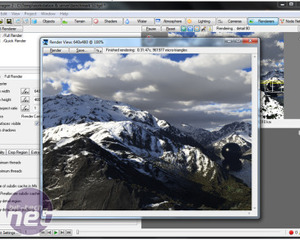Performance Analysis
Although both test systems have 24 execution units at their disposal, there is a significant difference in how AMD and Intel have implemented their workstation/server platforms. As these differences help to explain a lot of the performance analysis that follows, we thought it important to restate what they are.Namely, that the Opteron 6174 system has 24 physical cores clocked at 2.2GHz with quad-channel DDR3, whereas the Xeon 5650 system has 12 physical cores and 12 logical Hyper-Threaded cores clocked at 2.66GHz with triple-channel DDR3.
Workstation applications
Workstation applications historically haven't scaled much beyond eight threads, although that's now beginning to change. However, what hasn’t changed is that workstation applications such as 3D rendering and modelling packages are still very sensitive to the IPC (instructions per clock) and clock frequency of the CPU(s) they are being run on.As a result it came as no surprise to us that the Xeon X5650s took the lead in Cinebench R10 with an astonishing score of 32,724; even faster than the considerably more expensive and higher clocked quad-core Xeon W5580s. In contrast, the Opteron 6174s languished in third to last place, with a worse score than the previous generation Opteron 2435s. This might seem odd given that the Opteron 6174s have twice as many cores as the Opteron 2435s, but can be explained by the higher clock speed of the latter (2.6GHz versus 2.2GHz) and that Cinebench R10 does not support more than 16 threads.
Conversely in Cinebench R11, which uses a larger dataset than the R10 version, the Opteron 6174s snuck ahead of the Xeon X5650s. This is a great result for AMD, as in recent years Opterons have been much slower than Xeons in workstation applications.
Unfortunately, the good news didn’t carry over into our LightWave 9.6 benchmark, with the Xeon X5650s finishing the test considerably quicker than the new Opterons. However, the higher clocked Xeon W5580s retained its record breaking score of 66 seconds – clearly LightWave 9 still favours IPC and clock frequency over the number of cores.
HPC/server applications
Terragen 2 is by nature a graphics application so most people would traditionally think of it as a workstation application. However, given its computationally intensive nature we tend to think of it as a HPC (High-Performance Computing) application. The Xeon X5650s once again took the lead in this test, rendering the scene in six minutes and 55 seconds, just under two minutes faster than the Xeon W5580s. In contrast, the Opteron 6174s took a lengthy 12 minutes and 55 seconds, just over two minutes longer than the Opteron 2435s. Clearly, if you’re making the special effects for a film you should buy something from the Xeon 5600-series.
so most people would traditionally think of it as a workstation application. However, given its computationally intensive nature we tend to think of it as a HPC (High-Performance Computing) application. The Xeon X5650s once again took the lead in this test, rendering the scene in six minutes and 55 seconds, just under two minutes faster than the Xeon W5580s. In contrast, the Opteron 6174s took a lengthy 12 minutes and 55 seconds, just over two minutes longer than the Opteron 2435s. Clearly, if you’re making the special effects for a film you should buy something from the Xeon 5600-series.The Xeon 5650s also gave the Opteron 6174s a spanking in the CFD benchmark Euler3D. In this test the Xeon 5650s scored an astonishing 8.903Hz, versus just 3.502Hz for the Opteron 6174s. As we said in the original review of the first Nehalem EP-based Xeon, the W5580, if your business does any sort of CFD simulations then a Xeon is your first and only choice.
While the Opteron 6174s showed a big improvement in the FlamMap benchmark over the previous generation Opteron 2435s, the time taken to complete the test dropping from 177 seconds to 142 seconds, the Xeon X5650s were still a good deal faster, taking 119 seconds.
Interestingly, the Opteron 6174s proved slightly faster than the Xeon X5605s in the Folding@home test, with a massive ppd of 62,792 versus 62,102. Quite frankly, both results are simply amazing though; especially given how much more reliable a pair of these CPUs is than a rack full of GPUs.
Synthetic tests
While we don’t put much emphasis on synthetic tests, much preferring to run real-world applications as benchmarks, the Stream memory test does clearly highlight that the quad-channel architecture of the Opteron 6174 does deliver more memory bandwidth than the triple-channel architecture of the Xeon X5650s.The Opteron 6174s also finished the 32M test in WPrime slightly faster than the Xeon X5650s, showing that in some types of highly parallel simplistic maths calculations 24 physical cores are superior to 12 physical plus 12 logical Hyper-Threaded cores.
Power consumption
Interestingly, both systems drew an almost identical amount of power from the wall when both idle and under load. This is quite surprising, as historically speaking Xeons have consumed a lot more power than similarly-priced Opterons. All in all this can be only seen as good news for Intel given that the Xeon X5650s were faster than the Opteron 6174s in the majority of the tests.Conclusion
Intel is in a very strong position in the workstation/server market right now thanks to the performance lead of its Xeon 5500-series CPUs, and AMD is the distinct underdog. However, AMD has used this as a spur to redesign and re-organise its Opteron brand, dropping backwards compatibility with earlier models in order to simplify its range and boost performance. We're particularly pleased to see AMD finally taking the step of combining two multi-core dies - something Intel learned to do long ago. It may not be the most elegant way to get the job done, but performance results are what count to end-users.Thus, while the Xeon 5600-series builds on the success of the Xeon 5500-series, AMD has considerably upped the ante. The end result is far greater competition between Xeon and Opteron than there has been in recent years. For example, in contrast to when we last compared Xeon and Opteron, in which the Xeons took the lead in every benchmark; the Opteron 6174s did outperform the Xeon X5650s in several tests. This means it’s more important than ever before to choose the right hardware for your software. Complex simulations such as Folding@home take about the same time on both architectures, while CFD calculations are much faster on the Xeons.
That said, if you look at the big picture AMD still has its work cut out of it in the HPC/server application space as its latest Opteron 6174 lags behind the similarly priced Xeon X5650 in many of these applications. This is particularly true when you consider than the Opteron 6174 is the second fastest Opteron 6000-series CPU, while there are five faster Xeon 5600-series than the Xeon X5650s we tested. Thus, if all you want is the best possible performance from a dual-processor workstation/server, then the Xeon 5600-series is still the best choice.
In summary, while the Opteron 6174 and its Magny-Cours design are a great step forward for AMD, it’s still clear that whatever it does, what it really needs is a new core design; something that we’ll only see next year with the first Bulldozer CPUs.
AMD Opteron 6174
- Performance
- x
- x
- x
- x
- x
- x
- x
- x
- -
- -
- 8/10
- Value
- x
- x
- x
- x
- x
- x
- x
- -
- -
- -
- 7/10
- Overall
- x
- x
- x
- x
- x
- x
- x
- -
- -
- -
- 7/10
Intel Xeon X5650
- Performance
- x
- x
- x
- x
- x
- x
- x
- x
- x
- -
- 9/10
- Value
- x
- x
- x
- x
- x
- x
- x
- x
- -
- -
- 8/10
- Overall
- x
- x
- x
- x
- x
- x
- x
- x
- x
- -
- 9/10

Intel Xeon X5650

MSI MPG Velox 100R Chassis Review
October 14 2021 | 15:04










Want to comment? Please log in.